Molecular and Lased Desorption Methods for Bacterial Identification
VerifiedAdded on 2023/04/22
|6
|1705
|162
AI Summary
Contribute Materials
Your contribution can guide someone’s learning journey. Share your
documents today.
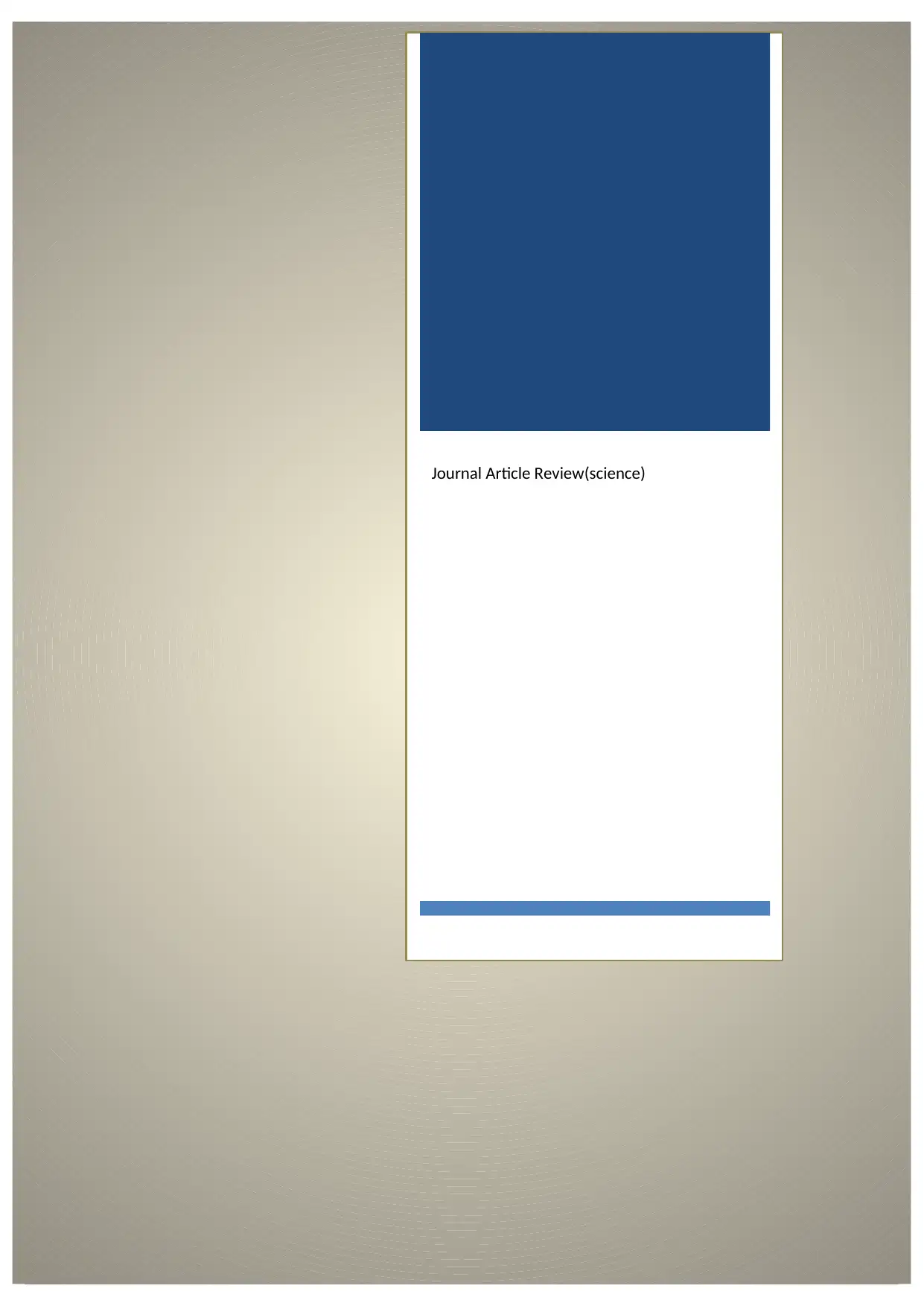
Journal Article Review(science)
Secure Best Marks with AI Grader
Need help grading? Try our AI Grader for instant feedback on your assignments.
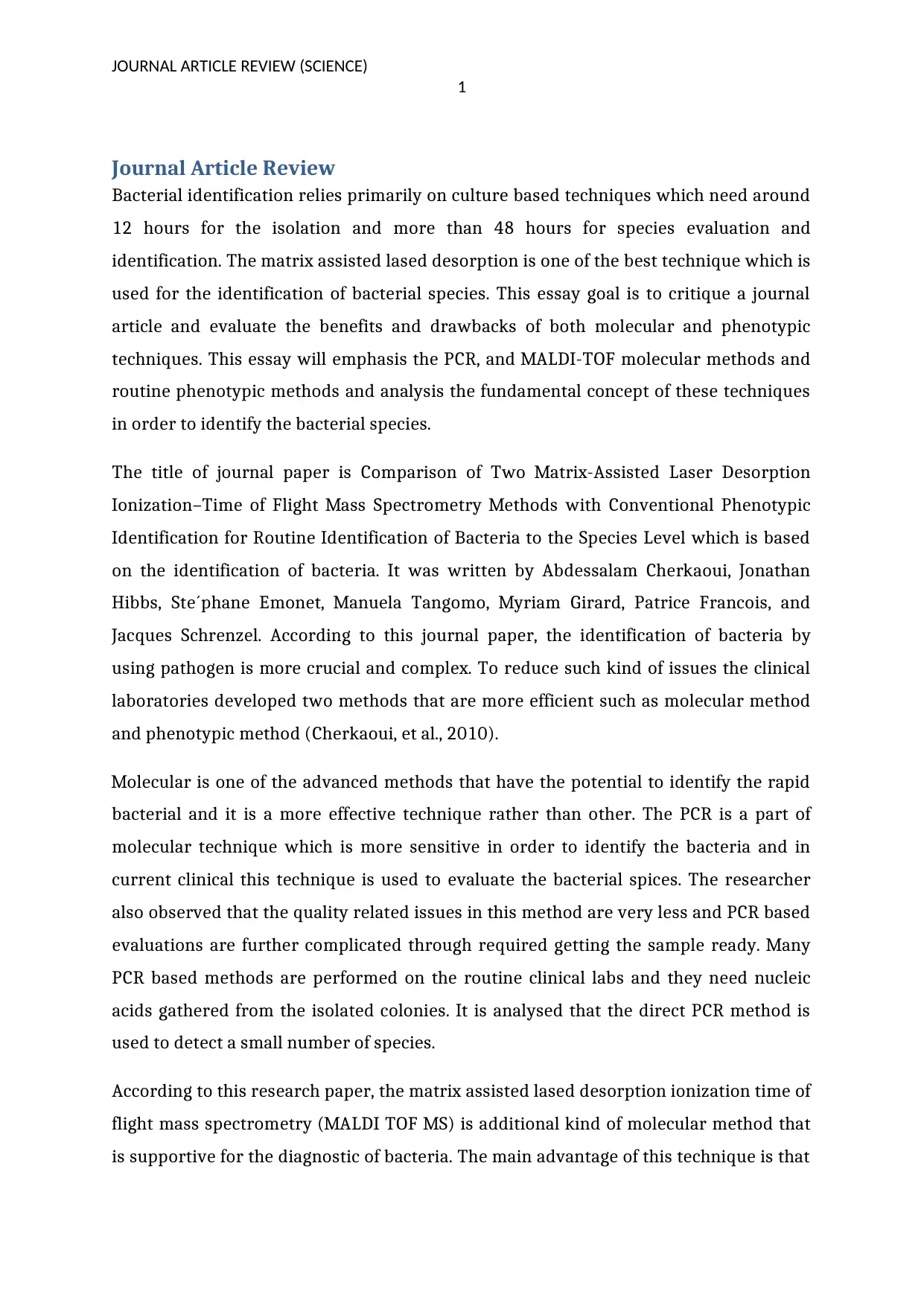
JOURNAL ARTICLE REVIEW (SCIENCE)
1
Journal Article Review
Bacterial identification relies primarily on culture based techniques which need around
12 hours for the isolation and more than 48 hours for species evaluation and
identification. The matrix assisted lased desorption is one of the best technique which is
used for the identification of bacterial species. This essay goal is to critique a journal
article and evaluate the benefits and drawbacks of both molecular and phenotypic
techniques. This essay will emphasis the PCR, and MALDI-TOF molecular methods and
routine phenotypic methods and analysis the fundamental concept of these techniques
in order to identify the bacterial species.
The title of journal paper is Comparison of Two Matrix-Assisted Laser Desorption
Ionization–Time of Flight Mass Spectrometry Methods with Conventional Phenotypic
Identification for Routine Identification of Bacteria to the Species Level which is based
on the identification of bacteria. It was written by Abdessalam Cherkaoui, Jonathan
Hibbs, Ste´phane Emonet, Manuela Tangomo, Myriam Girard, Patrice Francois, and
Jacques Schrenzel. According to this journal paper, the identification of bacteria by
using pathogen is more crucial and complex. To reduce such kind of issues the clinical
laboratories developed two methods that are more efficient such as molecular method
and phenotypic method (Cherkaoui, et al., 2010).
Molecular is one of the advanced methods that have the potential to identify the rapid
bacterial and it is a more effective technique rather than other. The PCR is a part of
molecular technique which is more sensitive in order to identify the bacteria and in
current clinical this technique is used to evaluate the bacterial spices. The researcher
also observed that the quality related issues in this method are very less and PCR based
evaluations are further complicated through required getting the sample ready. Many
PCR based methods are performed on the routine clinical labs and they need nucleic
acids gathered from the isolated colonies. It is analysed that the direct PCR method is
used to detect a small number of species.
According to this research paper, the matrix assisted lased desorption ionization time of
flight mass spectrometry (MALDI TOF MS) is additional kind of molecular method that
is supportive for the diagnostic of bacteria. The main advantage of this technique is that
1
Journal Article Review
Bacterial identification relies primarily on culture based techniques which need around
12 hours for the isolation and more than 48 hours for species evaluation and
identification. The matrix assisted lased desorption is one of the best technique which is
used for the identification of bacterial species. This essay goal is to critique a journal
article and evaluate the benefits and drawbacks of both molecular and phenotypic
techniques. This essay will emphasis the PCR, and MALDI-TOF molecular methods and
routine phenotypic methods and analysis the fundamental concept of these techniques
in order to identify the bacterial species.
The title of journal paper is Comparison of Two Matrix-Assisted Laser Desorption
Ionization–Time of Flight Mass Spectrometry Methods with Conventional Phenotypic
Identification for Routine Identification of Bacteria to the Species Level which is based
on the identification of bacteria. It was written by Abdessalam Cherkaoui, Jonathan
Hibbs, Ste´phane Emonet, Manuela Tangomo, Myriam Girard, Patrice Francois, and
Jacques Schrenzel. According to this journal paper, the identification of bacteria by
using pathogen is more crucial and complex. To reduce such kind of issues the clinical
laboratories developed two methods that are more efficient such as molecular method
and phenotypic method (Cherkaoui, et al., 2010).
Molecular is one of the advanced methods that have the potential to identify the rapid
bacterial and it is a more effective technique rather than other. The PCR is a part of
molecular technique which is more sensitive in order to identify the bacteria and in
current clinical this technique is used to evaluate the bacterial spices. The researcher
also observed that the quality related issues in this method are very less and PCR based
evaluations are further complicated through required getting the sample ready. Many
PCR based methods are performed on the routine clinical labs and they need nucleic
acids gathered from the isolated colonies. It is analysed that the direct PCR method is
used to detect a small number of species.
According to this research paper, the matrix assisted lased desorption ionization time of
flight mass spectrometry (MALDI TOF MS) is additional kind of molecular method that
is supportive for the diagnostic of bacteria. The main advantage of this technique is that
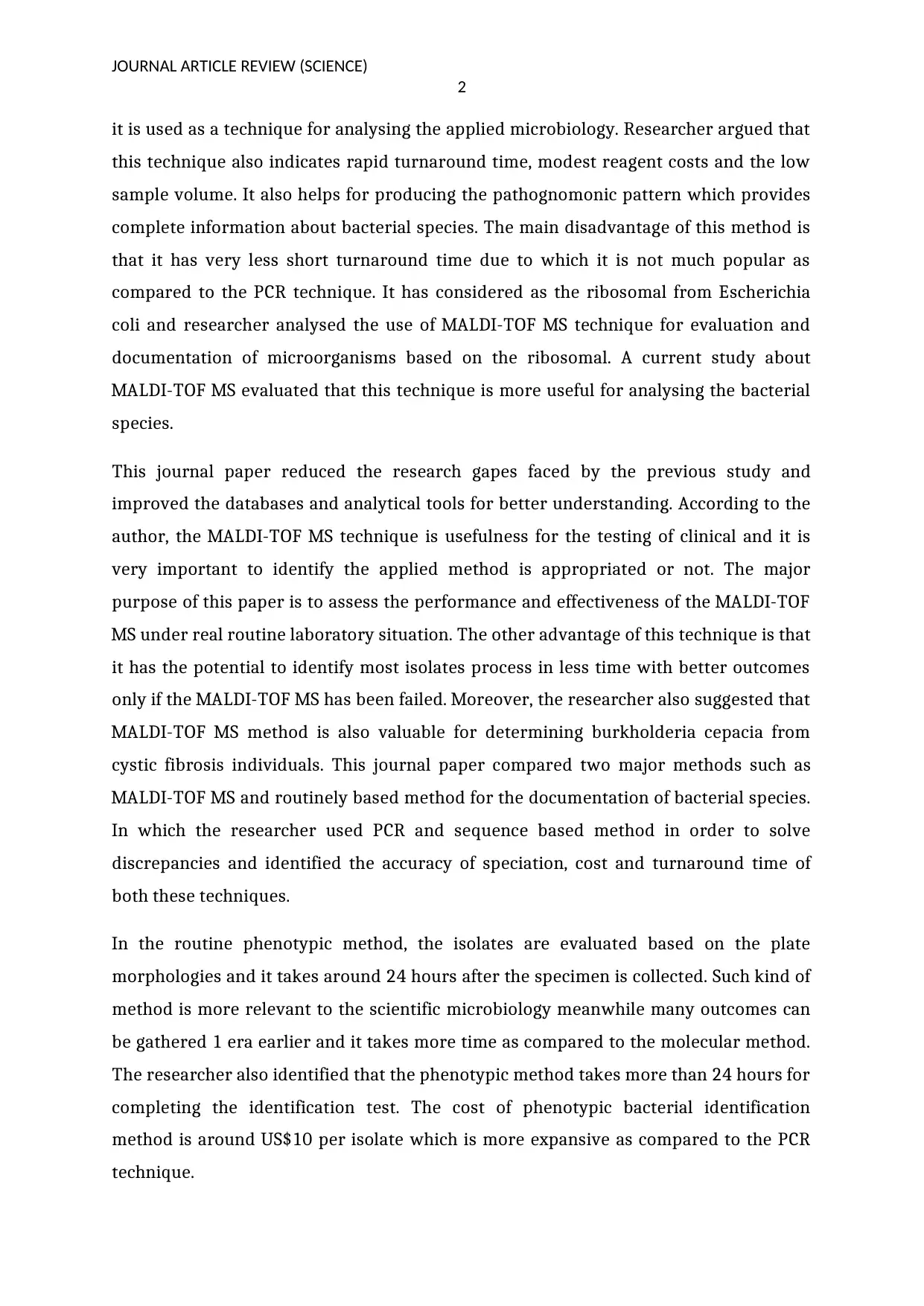
JOURNAL ARTICLE REVIEW (SCIENCE)
2
it is used as a technique for analysing the applied microbiology. Researcher argued that
this technique also indicates rapid turnaround time, modest reagent costs and the low
sample volume. It also helps for producing the pathognomonic pattern which provides
complete information about bacterial species. The main disadvantage of this method is
that it has very less short turnaround time due to which it is not much popular as
compared to the PCR technique. It has considered as the ribosomal from Escherichia
coli and researcher analysed the use of MALDI-TOF MS technique for evaluation and
documentation of microorganisms based on the ribosomal. A current study about
MALDI-TOF MS evaluated that this technique is more useful for analysing the bacterial
species.
This journal paper reduced the research gapes faced by the previous study and
improved the databases and analytical tools for better understanding. According to the
author, the MALDI-TOF MS technique is usefulness for the testing of clinical and it is
very important to identify the applied method is appropriated or not. The major
purpose of this paper is to assess the performance and effectiveness of the MALDI-TOF
MS under real routine laboratory situation. The other advantage of this technique is that
it has the potential to identify most isolates process in less time with better outcomes
only if the MALDI-TOF MS has been failed. Moreover, the researcher also suggested that
MALDI-TOF MS method is also valuable for determining burkholderia cepacia from
cystic fibrosis individuals. This journal paper compared two major methods such as
MALDI-TOF MS and routinely based method for the documentation of bacterial species.
In which the researcher used PCR and sequence based method in order to solve
discrepancies and identified the accuracy of speciation, cost and turnaround time of
both these techniques.
In the routine phenotypic method, the isolates are evaluated based on the plate
morphologies and it takes around 24 hours after the specimen is collected. Such kind of
method is more relevant to the scientific microbiology meanwhile many outcomes can
be gathered 1 era earlier and it takes more time as compared to the molecular method.
The researcher also identified that the phenotypic method takes more than 24 hours for
completing the identification test. The cost of phenotypic bacterial identification
method is around US$10 per isolate which is more expansive as compared to the PCR
technique.
2
it is used as a technique for analysing the applied microbiology. Researcher argued that
this technique also indicates rapid turnaround time, modest reagent costs and the low
sample volume. It also helps for producing the pathognomonic pattern which provides
complete information about bacterial species. The main disadvantage of this method is
that it has very less short turnaround time due to which it is not much popular as
compared to the PCR technique. It has considered as the ribosomal from Escherichia
coli and researcher analysed the use of MALDI-TOF MS technique for evaluation and
documentation of microorganisms based on the ribosomal. A current study about
MALDI-TOF MS evaluated that this technique is more useful for analysing the bacterial
species.
This journal paper reduced the research gapes faced by the previous study and
improved the databases and analytical tools for better understanding. According to the
author, the MALDI-TOF MS technique is usefulness for the testing of clinical and it is
very important to identify the applied method is appropriated or not. The major
purpose of this paper is to assess the performance and effectiveness of the MALDI-TOF
MS under real routine laboratory situation. The other advantage of this technique is that
it has the potential to identify most isolates process in less time with better outcomes
only if the MALDI-TOF MS has been failed. Moreover, the researcher also suggested that
MALDI-TOF MS method is also valuable for determining burkholderia cepacia from
cystic fibrosis individuals. This journal paper compared two major methods such as
MALDI-TOF MS and routinely based method for the documentation of bacterial species.
In which the researcher used PCR and sequence based method in order to solve
discrepancies and identified the accuracy of speciation, cost and turnaround time of
both these techniques.
In the routine phenotypic method, the isolates are evaluated based on the plate
morphologies and it takes around 24 hours after the specimen is collected. Such kind of
method is more relevant to the scientific microbiology meanwhile many outcomes can
be gathered 1 era earlier and it takes more time as compared to the molecular method.
The researcher also identified that the phenotypic method takes more than 24 hours for
completing the identification test. The cost of phenotypic bacterial identification
method is around US$10 per isolate which is more expansive as compared to the PCR
technique.
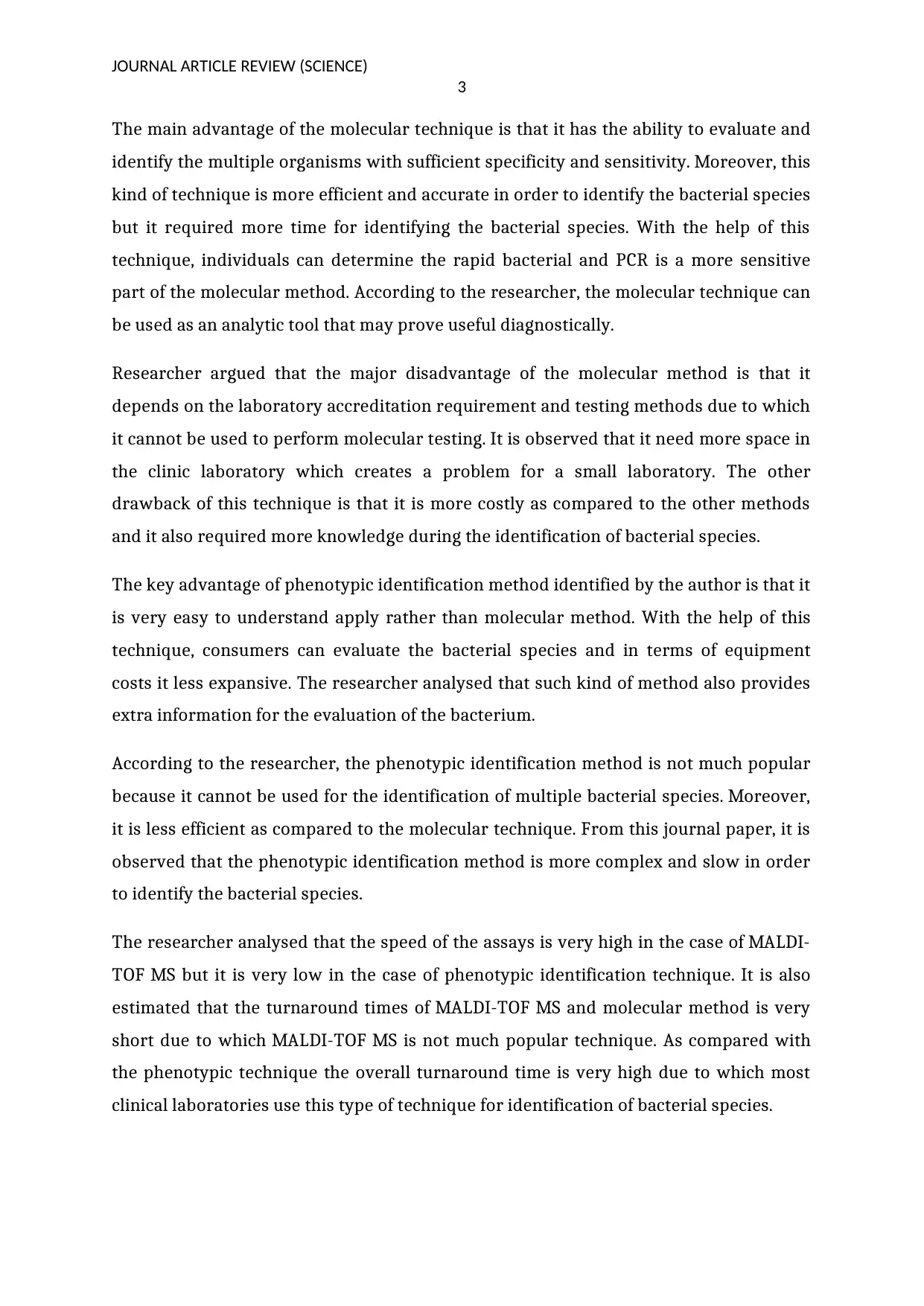
JOURNAL ARTICLE REVIEW (SCIENCE)
3
The main advantage of the molecular technique is that it has the ability to evaluate and
identify the multiple organisms with sufficient specificity and sensitivity. Moreover, this
kind of technique is more efficient and accurate in order to identify the bacterial species
but it required more time for identifying the bacterial species. With the help of this
technique, individuals can determine the rapid bacterial and PCR is a more sensitive
part of the molecular method. According to the researcher, the molecular technique can
be used as an analytic tool that may prove useful diagnostically.
Researcher argued that the major disadvantage of the molecular method is that it
depends on the laboratory accreditation requirement and testing methods due to which
it cannot be used to perform molecular testing. It is observed that it need more space in
the clinic laboratory which creates a problem for a small laboratory. The other
drawback of this technique is that it is more costly as compared to the other methods
and it also required more knowledge during the identification of bacterial species.
The key advantage of phenotypic identification method identified by the author is that it
is very easy to understand apply rather than molecular method. With the help of this
technique, consumers can evaluate the bacterial species and in terms of equipment
costs it less expansive. The researcher analysed that such kind of method also provides
extra information for the evaluation of the bacterium.
According to the researcher, the phenotypic identification method is not much popular
because it cannot be used for the identification of multiple bacterial species. Moreover,
it is less efficient as compared to the molecular technique. From this journal paper, it is
observed that the phenotypic identification method is more complex and slow in order
to identify the bacterial species.
The researcher analysed that the speed of the assays is very high in the case of MALDI-
TOF MS but it is very low in the case of phenotypic identification technique. It is also
estimated that the turnaround times of MALDI-TOF MS and molecular method is very
short due to which MALDI-TOF MS is not much popular technique. As compared with
the phenotypic technique the overall turnaround time is very high due to which most
clinical laboratories use this type of technique for identification of bacterial species.
3
The main advantage of the molecular technique is that it has the ability to evaluate and
identify the multiple organisms with sufficient specificity and sensitivity. Moreover, this
kind of technique is more efficient and accurate in order to identify the bacterial species
but it required more time for identifying the bacterial species. With the help of this
technique, individuals can determine the rapid bacterial and PCR is a more sensitive
part of the molecular method. According to the researcher, the molecular technique can
be used as an analytic tool that may prove useful diagnostically.
Researcher argued that the major disadvantage of the molecular method is that it
depends on the laboratory accreditation requirement and testing methods due to which
it cannot be used to perform molecular testing. It is observed that it need more space in
the clinic laboratory which creates a problem for a small laboratory. The other
drawback of this technique is that it is more costly as compared to the other methods
and it also required more knowledge during the identification of bacterial species.
The key advantage of phenotypic identification method identified by the author is that it
is very easy to understand apply rather than molecular method. With the help of this
technique, consumers can evaluate the bacterial species and in terms of equipment
costs it less expansive. The researcher analysed that such kind of method also provides
extra information for the evaluation of the bacterium.
According to the researcher, the phenotypic identification method is not much popular
because it cannot be used for the identification of multiple bacterial species. Moreover,
it is less efficient as compared to the molecular technique. From this journal paper, it is
observed that the phenotypic identification method is more complex and slow in order
to identify the bacterial species.
The researcher analysed that the speed of the assays is very high in the case of MALDI-
TOF MS but it is very low in the case of phenotypic identification technique. It is also
estimated that the turnaround times of MALDI-TOF MS and molecular method is very
short due to which MALDI-TOF MS is not much popular technique. As compared with
the phenotypic technique the overall turnaround time is very high due to which most
clinical laboratories use this type of technique for identification of bacterial species.
Secure Best Marks with AI Grader
Need help grading? Try our AI Grader for instant feedback on your assignments.
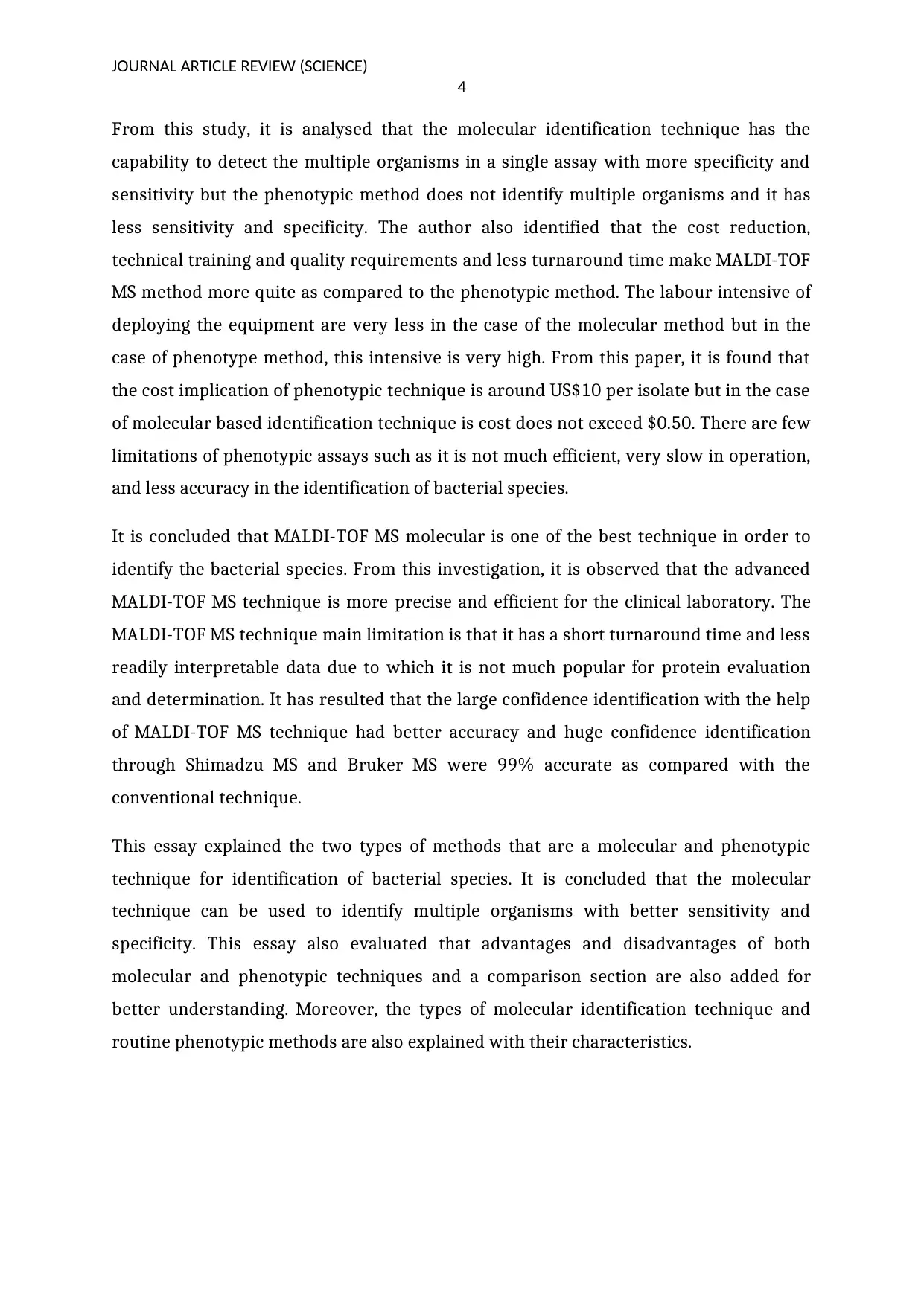
JOURNAL ARTICLE REVIEW (SCIENCE)
4
From this study, it is analysed that the molecular identification technique has the
capability to detect the multiple organisms in a single assay with more specificity and
sensitivity but the phenotypic method does not identify multiple organisms and it has
less sensitivity and specificity. The author also identified that the cost reduction,
technical training and quality requirements and less turnaround time make MALDI-TOF
MS method more quite as compared to the phenotypic method. The labour intensive of
deploying the equipment are very less in the case of the molecular method but in the
case of phenotype method, this intensive is very high. From this paper, it is found that
the cost implication of phenotypic technique is around US$10 per isolate but in the case
of molecular based identification technique is cost does not exceed $0.50. There are few
limitations of phenotypic assays such as it is not much efficient, very slow in operation,
and less accuracy in the identification of bacterial species.
It is concluded that MALDI-TOF MS molecular is one of the best technique in order to
identify the bacterial species. From this investigation, it is observed that the advanced
MALDI-TOF MS technique is more precise and efficient for the clinical laboratory. The
MALDI-TOF MS technique main limitation is that it has a short turnaround time and less
readily interpretable data due to which it is not much popular for protein evaluation
and determination. It has resulted that the large confidence identification with the help
of MALDI-TOF MS technique had better accuracy and huge confidence identification
through Shimadzu MS and Bruker MS were 99% accurate as compared with the
conventional technique.
This essay explained the two types of methods that are a molecular and phenotypic
technique for identification of bacterial species. It is concluded that the molecular
technique can be used to identify multiple organisms with better sensitivity and
specificity. This essay also evaluated that advantages and disadvantages of both
molecular and phenotypic techniques and a comparison section are also added for
better understanding. Moreover, the types of molecular identification technique and
routine phenotypic methods are also explained with their characteristics.
4
From this study, it is analysed that the molecular identification technique has the
capability to detect the multiple organisms in a single assay with more specificity and
sensitivity but the phenotypic method does not identify multiple organisms and it has
less sensitivity and specificity. The author also identified that the cost reduction,
technical training and quality requirements and less turnaround time make MALDI-TOF
MS method more quite as compared to the phenotypic method. The labour intensive of
deploying the equipment are very less in the case of the molecular method but in the
case of phenotype method, this intensive is very high. From this paper, it is found that
the cost implication of phenotypic technique is around US$10 per isolate but in the case
of molecular based identification technique is cost does not exceed $0.50. There are few
limitations of phenotypic assays such as it is not much efficient, very slow in operation,
and less accuracy in the identification of bacterial species.
It is concluded that MALDI-TOF MS molecular is one of the best technique in order to
identify the bacterial species. From this investigation, it is observed that the advanced
MALDI-TOF MS technique is more precise and efficient for the clinical laboratory. The
MALDI-TOF MS technique main limitation is that it has a short turnaround time and less
readily interpretable data due to which it is not much popular for protein evaluation
and determination. It has resulted that the large confidence identification with the help
of MALDI-TOF MS technique had better accuracy and huge confidence identification
through Shimadzu MS and Bruker MS were 99% accurate as compared with the
conventional technique.
This essay explained the two types of methods that are a molecular and phenotypic
technique for identification of bacterial species. It is concluded that the molecular
technique can be used to identify multiple organisms with better sensitivity and
specificity. This essay also evaluated that advantages and disadvantages of both
molecular and phenotypic techniques and a comparison section are also added for
better understanding. Moreover, the types of molecular identification technique and
routine phenotypic methods are also explained with their characteristics.
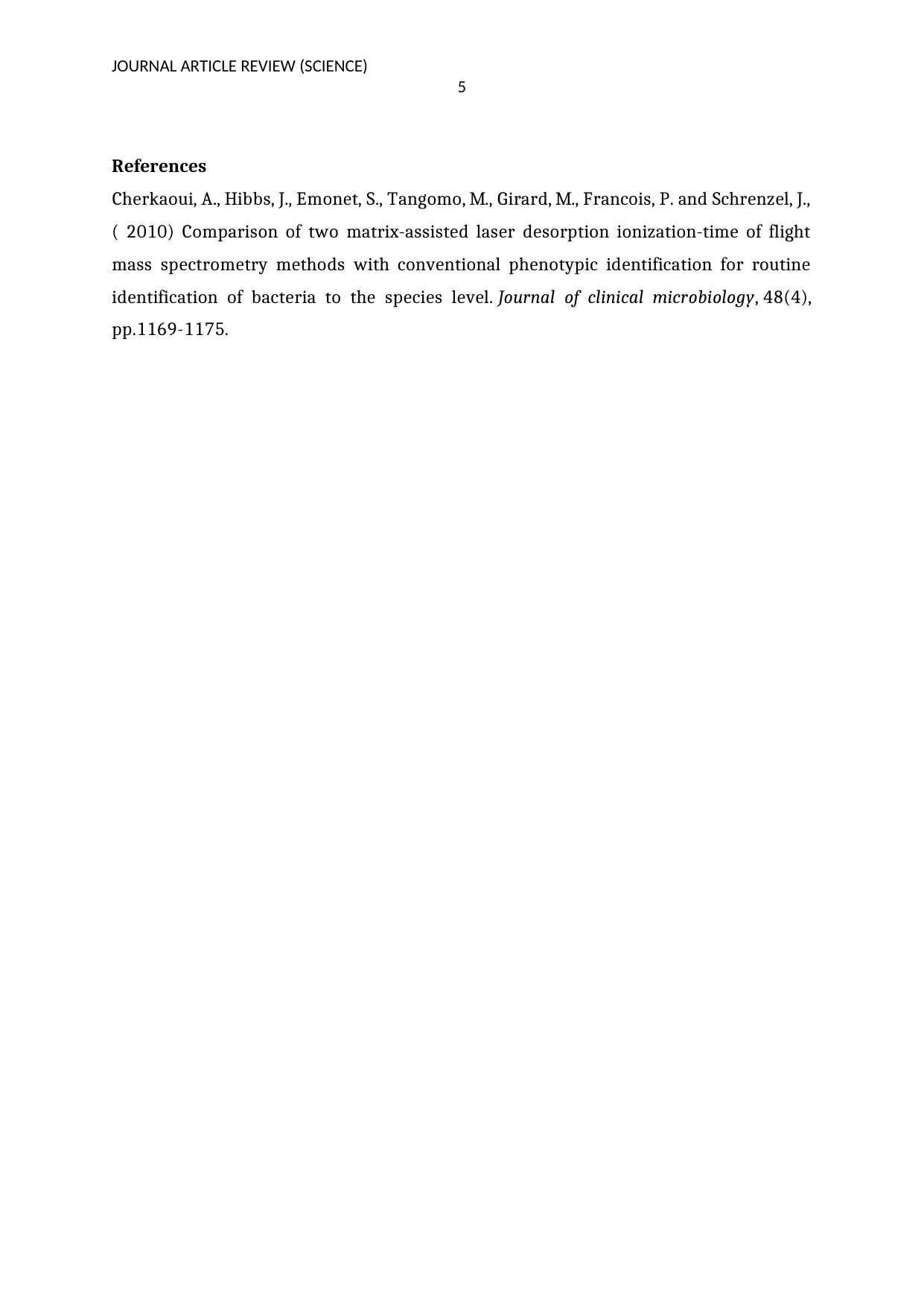
JOURNAL ARTICLE REVIEW (SCIENCE)
5
References
Cherkaoui, A., Hibbs, J., Emonet, S., Tangomo, M., Girard, M., Francois, P. and Schrenzel, J.,
( 2010) Comparison of two matrix-assisted laser desorption ionization-time of flight
mass spectrometry methods with conventional phenotypic identification for routine
identification of bacteria to the species level. Journal of clinical microbiology, 48(4),
pp.1169-1175.
5
References
Cherkaoui, A., Hibbs, J., Emonet, S., Tangomo, M., Girard, M., Francois, P. and Schrenzel, J.,
( 2010) Comparison of two matrix-assisted laser desorption ionization-time of flight
mass spectrometry methods with conventional phenotypic identification for routine
identification of bacteria to the species level. Journal of clinical microbiology, 48(4),
pp.1169-1175.
1 out of 6
Your All-in-One AI-Powered Toolkit for Academic Success.
+13062052269
info@desklib.com
Available 24*7 on WhatsApp / Email
![[object Object]](/_next/static/media/star-bottom.7253800d.svg)
Unlock your academic potential
© 2024 | Zucol Services PVT LTD | All rights reserved.

